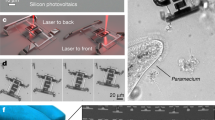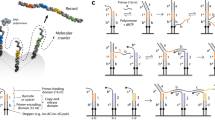Abstract
Recent proposals to analyze a number of major genomes have created a need for methods of rapidly manipulating and assaying very large numbers of specimens containing DNA fragments. Systems for sampling semi-solid biological material from mixed disordered arrays are required. These samples need to be sorted in an ordered format and stored in minimum space at known locations. It should be possible to recall them quickly from stock, individually or collectively, for duplication or re-ordering into new arrays for appropriate analysis. This article reviews a range of problems associated with high speed multiple specimen handling and assay in the molecular biology laboratory and outlines the solutions currently available to address these difficulties. Designs for automatic systems to manipulate bio-samples and analyze DNA are presented.
This is a preview of subscription content, access via your institution
Access options
Subscribe to this journal
Receive 12 print issues and online access
$209.00 per year
only $17.42 per issue
Buy this article
- Purchase on Springer Link
- Instant access to full article PDF
Prices may be subject to local taxes which are calculated during checkout
Similar content being viewed by others
References
Olsen, M., Hood, L., Cantor, C. and Bostein, D. 1989. A common language for physical mapping of the human genome. Science 245: 1434–1435.
Roberts, L. 1989. New game plan for genome mapping. Science 245: 1438–1440.
Beckmann, J.S. and Soller, M. 1990. Toward a unified approach to genetic mapping of eucaryotes based on sequence tagged microsatellite sites. Bio/Technology 8: 930–932.
Burke, D.T., Carle, G.F. and Olsen, M.V. 1987. Cloning of large segments of exogenous DNA into yeast by means of artificial chromosome vectors. Science 236: 806–812.
Drmanac, R., Laqbat, I., Brukner, I. and Crkvenjakov, R. 1988. Sequencing of megabase plus DNA by hybridisation: Theory of the method. Genomics 4: 114–128.
Rommens, J.M., Ianuzzi, M.C., Kerem, B., Drumm, M.C., Melmer, G., Dean, M., Rozmahel, R., Cole, J.L., Kennedy, D., Hidaka, N., Zsiga, M., Buchwald, M., Riordan, J.R., Tsui, L.P. and Collins, F.S. 1989. Identification of the cystic fibrosis gene: Chromosome walking and jumping. Science 245: 1059–1065.
Evans, G.A. and Lewis, K.A. 1989. Physical mapping of complex genomes by cosmid multiplex analysis. Proc. Natl. Acad. Sci. USA. 86: 5030–5034.
Evans, G.A., Lewis, K. and Rothenberg, B.E. 1989. High efficiency vectors for cosmid microcloning and genomic analysis. Gene 79: 9–20.
Michiels, F., Craig, A.G., Zehetner, G., Smith, G.P. and Lehrach, H. 1987. Molecular approaches to genome analysis: a strategy for the construction of ordered overlapping clone libraries. Cabios 3: 203–210.
Craig, A., Nizetic, D., Hoheisel, J., Zehetner, G. and Lehrach, H. 1990. Ordering of cosmid clones covering the herpes simplex virus type 1 (HSV-1) genome: A test case for fingerprinting by hybridisation. Nucleic Acids Res. 18: 2653–2660.
Wallace, R.B., Shaffer, J., Murphy, R.H., Hirose, T. and Itakura, K. 1979. Hybridisation of synthetic oligonucleotides to φx174 DNA. The effect of a single base pair mismatch. Nucl. Acids Res. 16: 3543–3557.
Bains, W. and Smith, G.C. 1988. A novel method for nucleic acid sequence determination. J. Theor. Biol. 135: 303–307.
Khrapko, K.R., Lysov, Y.P., Khorlyn, A.A., Shik, V.V., Florentiev, V.L. and Mirzabekov, A.D. 1989. An oligonucleotide hybridisation approach to DNA sequencing. FEBS Lets. 256: 118–122.
Jasiobedzki, P. and Martin, W.J. 1989. Processing of bacterial colony images for automatic isolation and transfer. J. Phys. E. Sci. Instr. 22: 364–367.
Martin, W.J. 1988. Charting the human genome—a design role for the life-science laboratory instrument engineer. J. Phys. E. Sci. Instr. 21: 336–347.
Courtney, P., Beck, M.S. and Martin, W.J. 1990. A vision guided life-science laboratory robot. Measurement Science and Technology (Submitted).
Martin, W.J. and Sims, P.F.G. 1990. Instrumenting access to the human genome (120 pages, 130 references). The Human Genome Management Information System. Oak Ridge National Laboratory, Oak Ridge, TN 37831, USA.
Author information
Authors and Affiliations
Rights and permissions
About this article
Cite this article
Martin, W., Walmsley, R. Vision Assisted Robotics and Tape Technology in the Life-Science Laboratory: Applications to Genome Analysis. Nat Biotechnol 8, 1258–1262 (1990). https://doi.org/10.1038/nbt1290-1258
Issue Date:
DOI: https://doi.org/10.1038/nbt1290-1258



